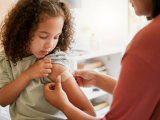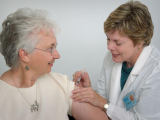Jun 20, 2012 (CIDRAP News) – The US Center for Disease Control and Prevention's (CDC) vaccine advisory group today heard the latest information on flu vaccine effectiveness and safety and updated its recommendation on the number of flu vaccine doses children under age 9 should receive.
The Advisory Committee on Immunization Practices (ACIP), on the first day of a 2-day meeting at CDC headquarters in Atlanta, also received a briefing on the past flu season and what's in store for the upcoming season's vaccine.
Lyn Finelli, DrPH, chief of the surveillance and outbreak response team in the CDC's Influenza Division, said the flu infection rate overall during the 2011-2012 was about half that of the previous year, with infections in children younger than 4 years old only a quarter of what they were last season.
Influenza experts aren't sure why the season was so mild, but she said several factors may have contributed to the low level of activity, including the third season of 2009 H1N1 virus circulation and the second season of the same H3N2 and influenza B strains. Over the past few years there's been an overall good match between the vaccines and the circulating strains, and good vaccine coverage and natural immunity from infection may have played a role in keeping the disease's impact low, she said.
David Shay, MD, MPH, , a medical offer with the CDC's National Center for Immunization and Respiratory Diseases, told ACIP members that the CDC's review of flu vaccine effectiveness now includes five study sites and covers a wider geographic area. Interim findings, based on an analysis of data collected from January through March, suggest that the effectiveness of seasonal flu vaccines was about 50%, with effectiveness levels holding steady by age-group.
The interim results are based on 329 RT-PCR-confirmed flu cases and more than 3,000 controls who had flu-like illness but tested negative for flu, he said, adding that officials hope to have a more definitive estimate soon, which will be based on about 700 confirmed cases. Early findings suggest the vaccine was about 47% effective against influenza A/H3N2 strains and 80% effective against 2009 H1N1 and influenza B.
In response to ACIP member questions, Shay said limited data so far showed a late-season drop in vaccine effectiveness against H3N2, but investigators don't have enough data yet to fully tease out H3N2 patternsor assess the possible role of waning protection.
He noted that the high effectiveness against influenza B seems surprising, given that many of the circulating influenza B viruses were not from the lineage included in the seasonal vaccine. However, he added that vaccine-effectiveness surveillance systems in Canada and Europe have noted the same pattern, along with lower effectiveness against H3N2.
Shay said that as in previous years, researchers didn't collect enough case data to make a separate estimate of vaccine effectiveness in seniors, a group that has a weakened immune response to flu vaccination. He said talks are underway to more actively enroll seniors, who he said seem less likely than younger patients to come to clinics when they have flu-like symptoms. He also said the group doesn't have enough data to make a separate estimate for the live-attenuated flu vaccine.
Last year a meta-analysis raised questions about the effectiveness of standard flu vaccines. The strict meta-analysis of high-quality randomized controlled trials, published in Lancet Infectious Diseases last October, put seasonal flu vaccine efficacy at 59% for adults younger than 65, which was lower than commonly cited 70% to 90% estimates.
During the flu vaccine safety presentation, Tom Shimabukuro, MD, MPH, with the CDC's National Center for Emerging and Zoonotic Infectious Diseases, told members that vaccine safety surveillance systems showed no elevated risk of Guillain-Barre syndrome after flu vaccination during the 2011-12 flu season. He also said no new safety concerns have been seen for the high-dose influenza vaccine for seniors.
The CDC received 51 reports for the new intradermal flu vaccine through the Vaccine Adverse Reporting System (VAERS), and 96% were not serious, which is reassuring, Shimabukuro said.
VAERS data have shown no increases in flu vaccine adverse effects such as allergic reactions and anaphylaxis, which is also reassuring, he said, in light of last year's recommendation that flu vaccination is safe for most people with egg allergies.
Recommendation for children adjusted
In other developments, the group unanimously approved a recommendation on the number of seasonal flu vaccine doses for children ages 6 months to 8 years. The move was prompted in part by the change of two strains in the vaccine for the 2012-13 flu season. Experts typically recommend that younger children receive two doses of flu vaccine given 1 month apart as a prime-boost strategy.
ACIP members debated two options, but approved one that has already been favored by the American Academy of Pediatrics (AAP). The recommendation is that for the upcoming season, children who have received two or more flu vaccine doses since 2010 should receive one dose. If not, they should receive two doses. They included a clarification that says providers can consider one dose if children received flu vaccine doses prior to July 2010.
The ACIP meeting continues tomorrow with discussions that include federal agency updates, adult immunization, anthrax vaccine, human papillomavirus vaccine uptake, and measles, mumps, and rubella vaccine.
ACIP recommendations become official when they are published in the CDC's Morbidity and Mortality Weekly Report.
See also:
ACIP meeting agenda
ACIP Webcast link


















